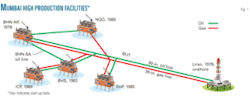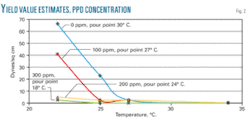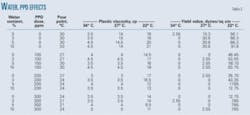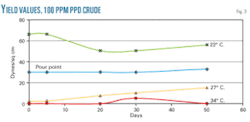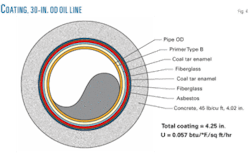Solution gases and reservoir pressure can allow operation of offshore transmission pipelines carrying high pour point, paraffinic crude without pour point depressant (PPD), even during periods of prolonged shutdown. Eliminating use of PPD leads to operational savings.
This article uses the Mumbai High-Uran pipeline offshore India to demonstrate the viability of operating such systems without PPD.
Background
Mumbai High-Uran subsea crude oil trunkline (BUT) is a 30-in. OD, 203 km pipeline carrying Mumbai High crude oil to the Uran onshore terminus (Fig 1). The pipeline is buried and insulated and was commissioned in 1979. Recent data allow a reexamination of the salient aspects of its operation.
Mumbai High crude is paraffinic with an average pour point of 30º C. and wax content of 10-16% (average ≈13%). A 300-ppm PPD dose lowered pour point to 18º C. and yield to 10.2 dynes/sq cm (at 20° C.). PPD dosing also ensured easy restartability after prolonged shutdown and inhibited wax deposition. Earlier estimates placed cooling during a longer shutdown at 18º C., resulting in a high break through pressure.
Table 1 provides detailed characteristics of Mumbai High’s crude oils.
PPD requirement
A series of reports details the occasional need for PPD in the pipeline.1 A study of the range of crude behavior in the laboratory and field integrated the latest information for the purpose of exploring flow assurance without PPD.2
Waxy crudes behave as Newtonian fluids above pour point temperature, exhibiting low viscosity and yield stress. Viscosity and yield value rise abruptly when crude oil cools below pour point.3 4 Pour point’s importance, however, is overstated, only showing when gel is formed but providing no information about the gel’s strength. Applying a small stress, even at temperatures lower than pour point, can destroy a weak wax crystal network.
Reports suggest lab yield stress values give a higher estimate of restartability pressure. Pressure and solution gas substantially improve rheology and restartability.5 6 Assessing heat loss in pipelines becomes crucial, temperature being the single most important parameter affecting crude rheology near pour point temperatures.
Methodology
Studies conducted in an offshore laboratory and field pipeline gathered about 1,000 sets of data on the oil’s behavior, pipeline shutdown conditions, bathymetry, and other subjects.
Lab and field studies focused on the following topics, integrating the results:
- —Temperature’s effect on PPD dosage.
- —Water cut’s (free and emulsified) effect on PPD dosage.
- —Gas-water’s effect on oil’s congealing behavior.
- —PPD’s efficiency over time.
- —Studies on 16-in. OD BHN-SA well fluid line to observe oil congealing and cooling under static and subsea temperature conditions over a prolonged period.
- —Data of shutdown and restarting the BUT oil line over the past 2 decades, temperature profile of the pipeline route, bathymetry, etc.
- —Pour point studies under pipeline conditions.
A six-speed Fann VG meter with a programmed cooling bath performed rheology. Rheology between 34° C. and 22° C. was estimated. ASTM D-97 method determined pour point.
Researchers built an apparatus to measure pour point under live pipeline conditions. Oil from the separator line was directly collected. ASTM D-97 guided maintenance of cooling cycles.
Emulsion studies on an offshore platform used fresh untreated crude from the pipeline. Adding produced water and blending for 5 min prepared the emulsions. Free water studies used a 2% emulsion with water added.
Field trials occurred on the 16-in., 20 km BHN-SA subsea pipeline after it had been filled with well fluid.
Results
Yield value increase when crude oil cools. Yield value estimates of crude oil with different PPD dosages took place at different temperatures. Fig. 2 shows the results.
- Untreated crude oil shows an abrupt rise in rheological parameters when cooled below 27° C.
- PPD =200 ppm improves crude rheology at low temperatures (below 25° C.).
- PPD has no effect on rheological parameters at higher temperatures, as untreated crude has low viscosity and yield values at 30° C. and greater.
Water effect
Crude oil traveling through a trunkline invariably transports water. The following combinations comprehensively studied the effect of emulsified water on pour point:
- Mixing 3, 5, and 10% water to PPD-treated crude and making emulsion.
- Mixing 3, 5, and 10% water to PPD untreated crude and making emulsion.
Table 2 shows the studies’ results, demonstrating water cut as not having any adverse impact on rheology at temperatures warmer than 27° C. PPD improves rheology of emulsion at temperatures 27° C. and below.
The following combinations comprehensively study the effect of free water on pour point:
- Mixing 2, 5, and 10% water (free water) in 2% emulsion of untreated crude.
- Mixing 2, 5, and 10% water (free water) in 2% emulsion of PPD treated crude
Table 3 shows the results, yielding the following conclusions:
- Free water association deteriorates rheology of crude oil marginally.
- PPD improves crude oil rheology in emulsions as well as in free water association.
Gas, pressure
Crude oil pumped in the BUT line is not stabilized. Pumping occurs directly from surge tanks maintained at 4 kg/sq cm. Pour points estimated on stabilized crude do not reflect pipeline conditions where dissolved gas and pressure are present, mandating in-line testing.
The pipeline’s pour point measured 27° C., 3° C. less than stabilized crude. The combined effect of lighter components and pressure reduced pour point by the 3° C.
Aging
Pipeline shutdown subjects crude oil to aging, which may deteriorate its rheology. Studies therefore occurred on PPD treated and untreated crude 5, 20, 30, and 50 days old.
Fig. 3 shows yield values, demonstrating:
- Both PPD treated and untreated aged crude show only marginal increase in yield value.
- Above 27° C., crude rheology doesn’t deteriorate after aging for 30 days.
- Yield increases marginally when crude ages for more than 30 days.
Crude pour point doesn’t change after aging.
Cooling rate
Experiments at slow cooling rates sought to determine crude behavior in such pipelines. The BUT pipeline cools from 50° C. to ˜35° C. in 48 hr. Slow cooling results in a 3° C. lower pour point compared with ASTM-D-97. Lighter fractions present in the pipeline further depress pour point.
Field studies
The 16-in. OD, 20 km long BHN-SA subsea pipeline, filled with well fluid for more than 2 years, provided the location for field studies. Well fluid displacement used pressurized crude with a polypig in front, after which the line was kept static. Allowing 18 days to elapse resulted in 50% of line’s volume being displaced. Temperature and pressure readings and samples received at the SA end allowed analysis of pour point, viscosity, and yield value. Returning the line to a static condition for 20 more days resulted in additional crude displacement. A final shutdown left the pipeline idle for a total of 83 days. Table 4 shows field trial results.
Restart required minimum pressurization and oil was free flowing. Pressures at BHN and SA remained stable throughout the process. Pressure drop during the last phase of flow during field trial measured just 3.61 kg/sq cm. Minimum temperature observed was 22-23° C. This section of the pipeline is deepest and experiences maximum cooling.
Historical shutdowns
Following an accident on NF riser on May 16, 2003, pipeline repair and return to operation took 16 days. The pipeline was initially charged with water followed by crude oil from all platforms. Minimum crude oil temperature observed at the Uran end measured 28° C. In-pipeline heat losses were less severe than anticipated.
Oil between the BHN and BHS platforms (13.08 km) remained stagnant for 177 days during a 2001 revamping of BHN platform. After the wells were opened, fluid lines showed no increase in pressure.
The 30-in. OD BUT oil line ruptured Aug. 10, 2003, and was recommissioned Sept. 9, 2003. Oil inside the pipeline was predominantly untreated, with a PPD dose of only 30-40 ppm. Restart from BHN platform used water pumped at 300 cu m/hr. Pressure gradually rose to 9.3 kg/sq cm from 2 kg/sq cm on Sept. 10, 2003. End pressure at Uran increased to 6.5 kg/sq cm from 1.5 kg/sq cm when oil started flowing at 70 cu m/hr.
The pressure differences show oil in the pipeline had not gelled and continued to behave in a Newtonian manner. Temperature observed at Uran measured 29-30° C. after 30 days of pipeline shutdown, showing much less severe cooling than anticipated.
Bathymetry, temperature
BUT oil pipeline runs through water depths ranging from 80 m in Mumbai High North field to shore at Uran. The line lies 3-4 m below the seabed. Fiberglass, asbestos felt, and 4 in. of cement coat the pipeline (Fig. 4).
Average dispatch temperature of crude oil at various platforms measured 50-52° C. Crude temperature at Uran varies between 33° and 36° C., showing lower heat losses. Good insulation and higher subsea temperatures near shore helped reduce heat loss.
Table 5 shows water depth and maximum-minimum temperatures at various platforms en route to BUT line. Minimum temperature is above 25° C. near BLQ, NLM, and HRA platforms. Heat loss is greater at the Mumbai High end and decreases as oil travels toward Uran (Figs. 5-6).
null
Case histories of BUT pipeline show crude temperature dropping to only 27° C. even after 30 days shutdown, less severe than anticipated. Crude oil viscosity and yield value are quite low at 27° C., reducing the need for PPD-flow improver. Reducing PPD by 50% since January 2003 has not caused a pressure drop (Table 6).
PPD dosing halted in 2005, saving $12 million/year in operating expenses.
Acknowledgment
The authors are grateful to ONGC for according permission to publish these studies.
References
- “Transportation of Bombay High crude Through The Salaya Mathura Pipeline,” unpublished Snamprogetti Report (Job No. 45100), June 1982.
- Prasad, J., Sharma, V., Nimoria, S.R., Philip, P.C., and Verma, P.K., “Use of Pour Point Depressant in Mumbai Offshore,” unpublished ONGC report, April 2005.
- Udhe, A., and Kopp, G., “Pipeline Problems Resulting from the Handling of Waxy Crudes,” Journal of Institute of Petroleum, Vol. 57, No. 554, March 1971.
- Gaban, B., “Submarine Pipelining of High Pour Point Crude Oil,” Ninth Annual Convention, Jakarta, Indonesian Petroleum Association, May 1980.
- Prasad, J., and Choudhary, N., “Rheological Studies of Bombay High Crude Under Simulated Pipeline Conditions,” Hydrocarbon India, May 15, 1993.
- Sestak, J., Charles, M.F., Cakewell, M.G., Houska, M., “Start-Up of Gelled Crude Oil Pipelines,” Journal of Pipelines, Vol. 6, pp. 15-24, 1987.
The authors
Jitendra Prasad ([email protected]) is general manager of regional geoscience laboratories at Oil & Natural Gas Corp., India. He has worked in exploration and production, including offshore, at ONGC for 29 years. Prasad received a bachelor of technology degree from Kanpur University and a masters of technology in petroleum engineering from the Indian School of Mines, Dhanbad. He is a member of SPE.
Vinod Sharma is a general manager at ONGC working on developing drilling fluids systems at its institute at Dehradun (IDT, Institute of Drilling Technology). He holds a PhD in chemistry and has 32 years of experience in various oil industry segments, including offshore operations. Sharma is a member of SPE.
P.C. Phillip is a general manager at ONGC, responsible for drilling fluid operations in the Karaikal area. Phillip received a masters of philosophy degree in chemistry from Kerala University. He has 32 years of experience in various oil industry operations, including offshore process platforms.
S.R. Nimoria is a general manager at ONGC with 29 years’ oil industry experience in processing and drilling. Nimoria currently works in Mumbai area in materials management. He holds a postgraduate degree from Rajastan University and is a member of SPE.
P.K. Verma is president of Reliance Industries and is responsible for development of offshore KG field. Verma has over 34 years of experience in the oil industry and offshore operations. Prior to KG he was asset manager of Neelam and Heera fields. He holds a degree in petroleum engineering from Indian School of Mines (ISM), Dhanbad, and is a member of SPE.
